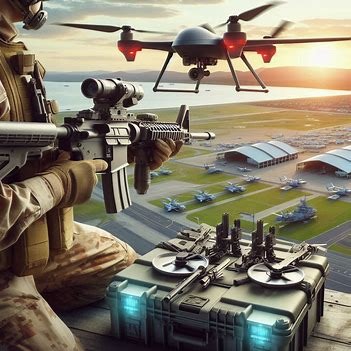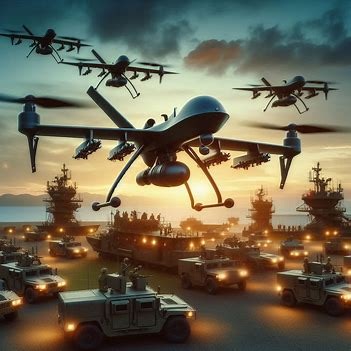
Revolutionizing Disaster Response and Military Operations
In an era of rapid technological advancement, drones have emerged as a transformative force in both humanitarian efforts and military operations. This dual-purpose technology is reshaping our approach to disaster response and defense strategies, offering unprecedented capabilities that were once the realm of science fiction.
Drones in Disaster Response: A Lifeline from Above
When natural disasters strike, the race against time to locate survivors and deliver aid becomes paramount. Unmanned Aerial Vehicles (UAVs) have proven to be invaluable assets in these critical moments, offering a bird’s-eye view of devastated areas and facilitating rapid, targeted responses.

In the aftermath of Hurricane Dorian in 2019, which ravaged the Bahamas with unprecedented fury, drones played a crucial role in search and rescue operations. Equipped with thermal imaging cameras, UAVs scanned debris fields and collapsed structures, detecting heat signatures of survivors who would have otherwise remained hidden from ground-based rescue teams. This technology enabled responders to prioritize their efforts, dramatically increasing the chances of survival for those trapped in the wake of the catastrophe.
The ability of drones to assess damage in disaster-hit areas has also significantly enhanced the efficiency of relief efforts. In the wake of the 2023 Turkey-Syria earthquake, drones equipped with high-resolution cameras and LiDAR technology were deployed to create detailed 3D maps of affected areas. These maps provided emergency responders and urban planners with crucial information for both immediate rescue operations and long-term reconstruction efforts.
Moreover, drones have revolutionized the delivery of essential supplies to isolated or inaccessible areas. In Rwanda, Zipline, a drone delivery company, has been operating a nationwide network of drones to deliver blood, vaccines, and other medical supplies to remote clinics since 2016. During the COVID-19 pandemic, this system proved invaluable, ensuring that critical medical resources reached even the most isolated communities without risking human-to-human transmission.
Military and Defense Applications: The Silent Sentinels
While drones have garnered attention for their humanitarian applications, their role in military and defense operations has been equally transformative. UAVs have become indispensable tools in modern warfare, offering unprecedented surveillance capabilities and precision strike options while minimizing risk to human personnel.
The use of drones in military operations was brought to the forefront during the conflict in Afghanistan. The MQ-9 Reaper, a formidable UAV equipped with advanced sensors and weaponry, played a pivotal role in gathering intelligence and conducting targeted strikes against insurgent forces. Its ability to loiter over areas of interest for extended periods provided commanders with real-time situational awareness, fundamentally altering the dynamics of asymmetric warfare.
Beyond combat operations, drones have proven invaluable in border surveillance and maritime patrol missions. The European Border and Coast Guard Agency (Frontex) has employed drones to monitor vast stretches of the Mediterranean Sea, enhancing their capacity to detect and respond to illegal border crossings and potential maritime disasters.
The integration of artificial intelligence and machine learning algorithms has further augmented the capabilities of military drones. Swarm technology, where multiple drones operate in coordinated formations, presents both exciting possibilities and daunting challenges for future conflicts. The ability to overwhelm enemy defenses with a swarm of low-cost, expendable drones could potentially reshape military doctrine and strategy in the coming decades.
Ethical Considerations and Future Prospects
The dual nature of drone technology—its capacity to save lives in disaster scenarios and its potential as a weapon of war—presents a complex ethical and policy challenge. As we continue to push the boundaries of what’s possible with UAVs, it becomes increasingly crucial to establish robust international frameworks governing their use in both civilian and military contexts.
Questions of privacy, sovereignty, and the potential for autonomous decision-making in military drones have sparked intense debate among policymakers, ethicists, and technologists. The development of AI-powered drones capable of making independent targeting decisions raises profound moral questions about the nature of warfare and human accountability.
Conclusion: Navigating the Dual-Use Dilemma
The transformative impact of drones in both disaster response and military operations is undeniable. In humanitarian contexts, they offer hope and tangible solutions in humanity’s darkest hours, providing critical support that can mean the difference between life and death. Simultaneously, their military applications have ushered in a new era of warfare, one that demands careful consideration of the ethical implications and potential consequences of autonomous weapons systems.
As we stand on the precipice of this technological revolution, it is imperative that we harness the potential of drones to serve the greater good while mitigating the risks associated with their misuse. Only through thoughtful regulation, international cooperation, and a commitment to ethical deployment can we ensure that this powerful technology remains a force for positive change in our ever-evolving world.
The future of drone technology in both disaster response and military applications is bound to be marked by continued innovation and ethical deliberation. As we navigate this complex landscape, our challenge will be to maximize the benefits of this remarkable technology while safeguarding against its potential for harm, ensuring that drones continue to serve as tools for progress, security, and humanitarian aid in the years to come.







